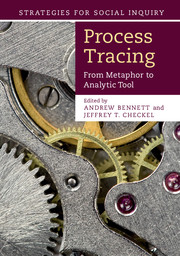Appendix - Disciplining our conjectures
Systematizing process tracing with Bayesian analysis
Published online by Cambridge University Press: 05 November 2014
Summary
One of the attractions of process tracing is that it does not require technical training to be able to use the method. Just as one can be a decent cook with only a recipe and an intuitive understanding of chemistry, it is possible to do process tracing well by following the prescriptive advice in Chapter 1 and having an intuitive understanding of its logic. Yet, sometimes our intuitive understandings lead us astray. Just as a cook who understands chemistry will be better able to develop new recipes, adapt to different kitchens and ingredients, and teach cooking to others, researchers who understand the underlying logic of process tracing are likely to be better able to do it, teach it, and defend their applications of it.
This appendix thus outlines the mathematical logic of process tracing. Although technical, it should be accessible to readers with modest exposure to algebra, probability theory, and formal logic. The Appendix focuses on Bayesian reasoning as one way of illuminating the logic that underlies deductive process tracing. An important caveat here is that although the logic of process tracing and that of Bayesianism have much in common, they are not entirely coterminous. In particular, the use of process tracing to generate theories by “soaking and poking” in the evidence does not (yet) have a place in Bayesian epistemology. Also, the logic underlying process tracing can be explicated in terms of set theory and directed acyclic graphs as well as Bayesianism. Yet, Bayesianism is the inferential logic that has been developed the furthest in the context of process tracing. Accordingly, this appendix first outlines the fundamentals of Bayesianism and then advances six important implications for process tracing. The underlying premise here is that more rigorous and explicit use of inferential logic in process tracing, whether Bayesianism, directed acyclic graphs, set theory, or some other logic, will contribute to better process tracing.
- Type
- Chapter
- Information
- Process TracingFrom Metaphor to Analytic Tool, pp. 276 - 298Publisher: Cambridge University PressPrint publication year: 2014
- 16
- Cited by

